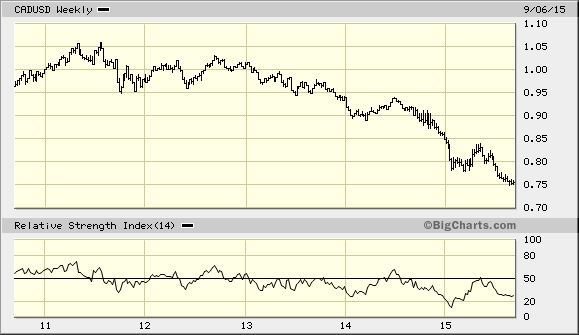 This has been a bad year for commodities, as most are in a waterfall decline. Currencies of countries which rely on commodity exports are facing the heat. The Canadian loonie is one among many, like the Brazilian real, Australian dollar and the Russian rouble, which have all suffered huge declines.
This has been a bad year for commodities, as most are in a waterfall decline. Currencies of countries which rely on commodity exports are facing the heat. The Canadian loonie is one among many, like the Brazilian real, Australian dollar and the Russian rouble, which have all suffered huge declines.
The Canadian dollar is down 16% this year and is at its 11-year low. (The last time the Canadian dollar was at 75 cents was in 2004.) The fall is attributed to the precipitous decline in crude oil prices, which have dropped from $91 per barrel to a low of $37.75 per barrel this year. The price recently rebounded to $45.77 per barrel Studying the charts of oil and the CAD side by side shows a clear similarity. At the same time, the CAD/USD has declined from $0.92 levels to $0.75 levels.
Correlation with oil

The chart above shows the correlation of crude oil and the loonie. This correlation has increased since 2004, as crude oil and the loonie mimic each other. In the past 10 years, the correlation of CAD/USD to oil has been a 0.78 positive relationship. Whenever oil prices recover, it is certain that the price of CAD/USD will also increase.
Reason for correlation
Exports of goods contribute 72% to the total current account receipts for Canada, and mineral fuels produce the most foreign exchange earnings. In the mineral fuels category, crude oil alone is the largest component. With a 15% share, crude oil is currently the largest contributor to Canada’s total foreign exchange earnings – no other service or income source contributes as much.
Though crude oil is just about 3% of GDP, it is the main foreign exchange earner. For the past 6 years growth in oil sands has brought about this increase in crude oil exports. Since crude oil is the front runner in earning foreign exchange, it is natural that the loonie’s movement is highly correlated to it.
Importance of crude oil
Canada’s annual crude oil production in 1990 was 609 million barrels. It reached 969 million barrels in 2006 and totaled 1,318 million barrels (3.61 million barrels per day) in 2014, which shows the rapid growth and importance of crude oil to the Canadian economy.
Oil sands contribute 60% of the total crude oil production in Canada. In 1990, annual production was 125 million barrels and by 2014, it had risen to 840 million barrels. Over the past 6 years, oil sands production has risen approximately 57%, which in turn increased their contribution to the country’s total current account receipts from 10% to 15%.
Flow of US dollars
Most of the trade in crude oil between nations is conducted in US dollars. Moreover, 97% of the crude oil exported by Canada is shipped to the US. All these transactions are done in US dollars. During high crude oil prices, more US dollars are earned by Canada for the same volume of crude exported.
With more US dollars in the hands of Canadians, the forces of supply and demand result in an increase in the value of the Canadian dollar relative to the US dollar. On the other hand, a dramatic fall in oil prices reduces US dollar earnings, thereby increasing the demand for US dollars and eventually leading to a fall in the value of Canadian dollars.
Conclusion
Due to the slide in the price of crude oil, industry players have reined in capital expenditures. This has had a cascading effect resulting in dramatically lower earnings and cash flow, not only for producers of crude but also for supporting players that cater to the industry. No doubt, this has contributed to a rise in the unemployment rate from 6.8% to 7%. Although the Bank of Canada has kept the benchmark interest rate at 0.5%, the US Fed may have grounds for an interest rate hike if labour market conditions continue to tighten, or simply to maintain some flexibility for a cut down the road if equity market conditions become too disquieting. Whatever the reason, this divergence will add to the woes of the Canadian dollar.
There is a bright light at the end of the tunnel, however. Irrespective of the volatility in the stock market, growth in the US is improving, which will give a boost to Canadian industries like aircraft, chemicals, vehicles, and electrical equipment as exports to the US will increase. The decrease in the price of crude oil may also increase profit margins in these industries. As such, the oil industry’s loss could produce meaningful gains for the manufacturing sector.
Crude oil at these levels appears to be pricing in a deep recession similar to The Great Recession of 2007-2009. However, the likelihood of the global economy re-entering a similar state is somewhat remote given the efforts that governments and Central Banks have dedicated to spurring growth, and to a lesser extent to addressing some of the underlying causes which led to the debacle. One thing is for sure: unless Canada diversifies its economy away from resources, the price of crude will continue to have a meaningful impact on the value of the Canadian dollar.

